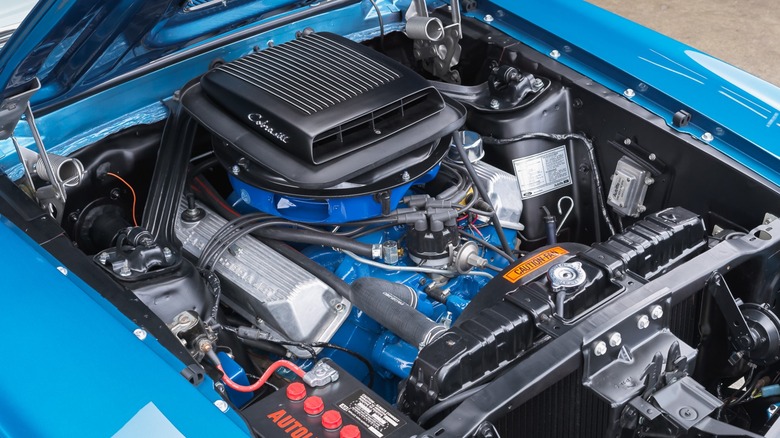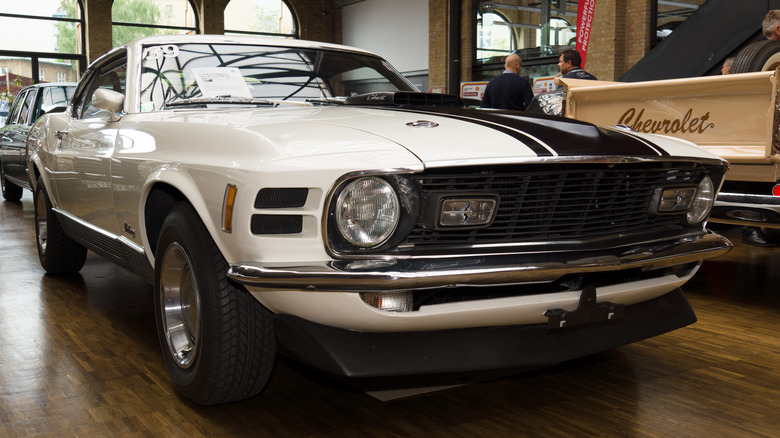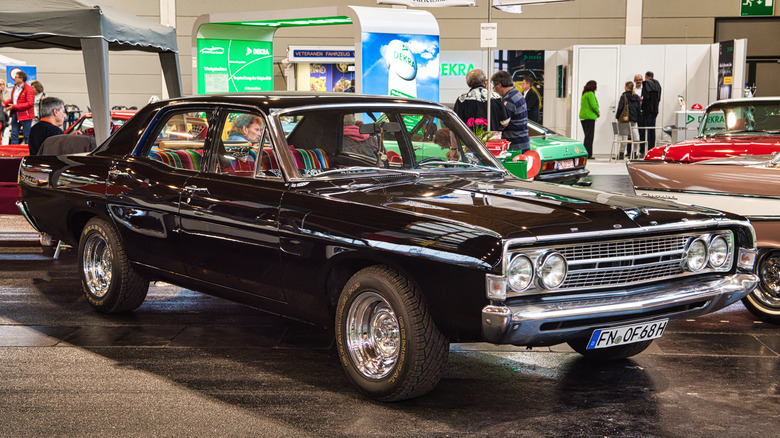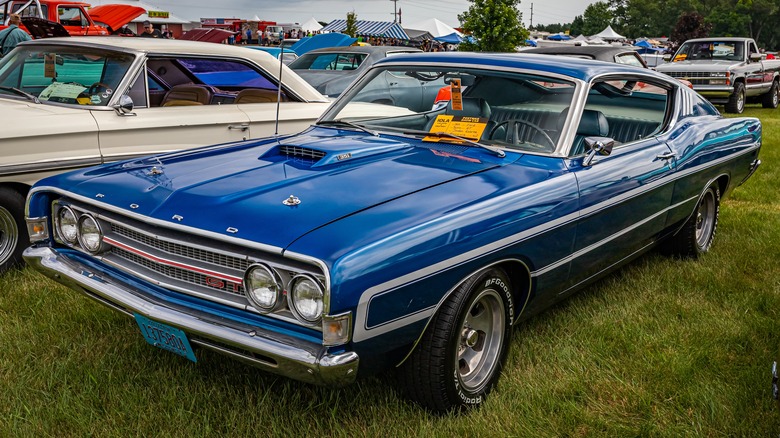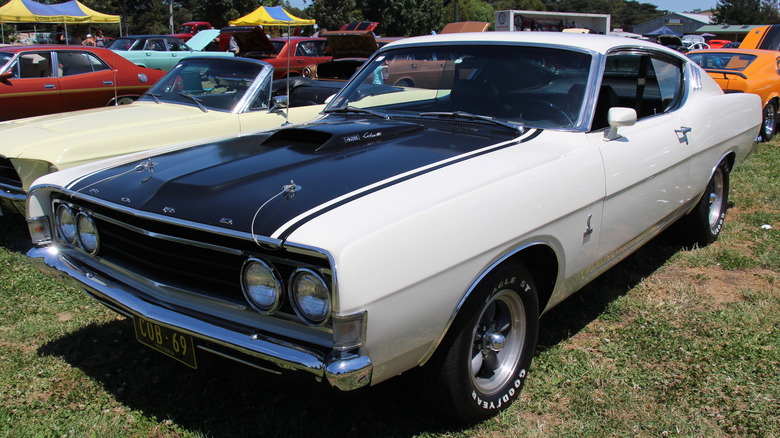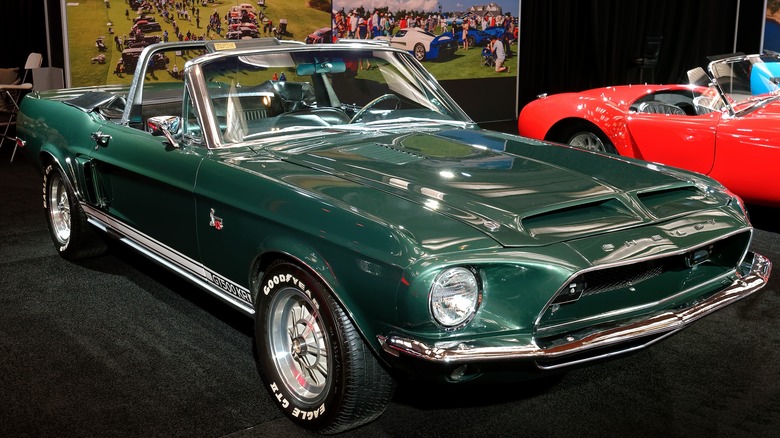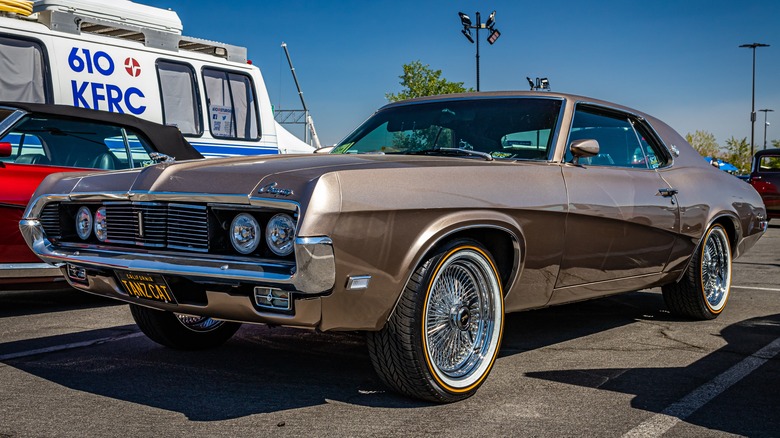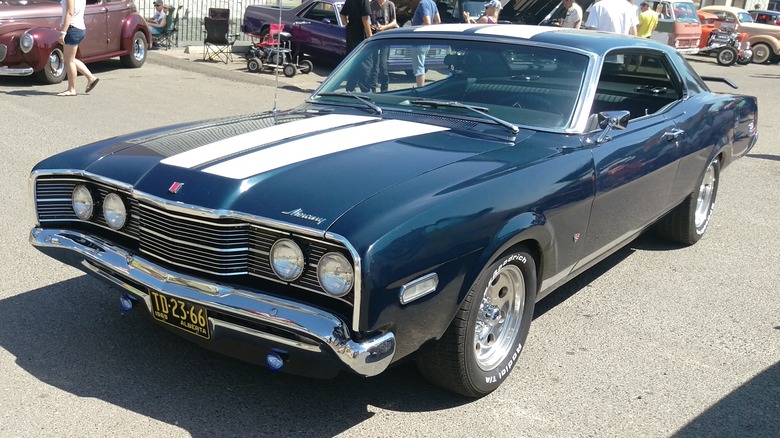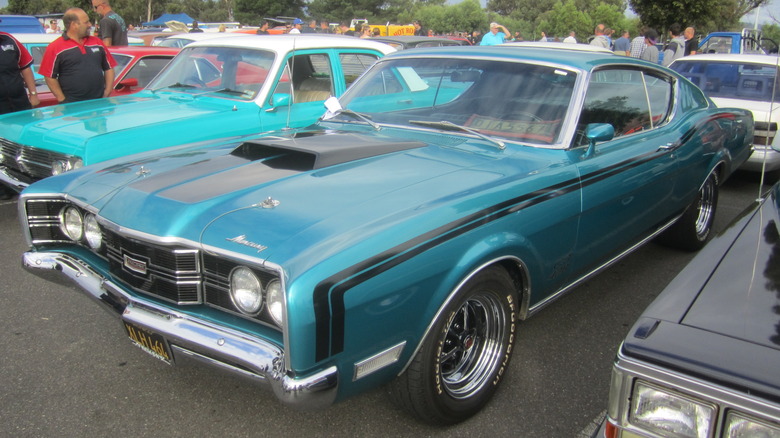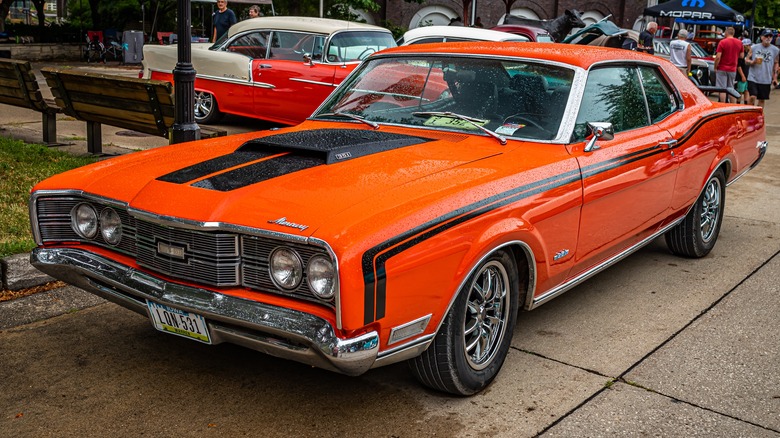Every Ford Model Powered By The 428 Cobra Jet Engine
As far as Ford Motor Company's big-block V8s go, few are as iconic as the Cobra Jet engine. First announced in late 1967 and made available in April 1968, the 428 Cobra Jet was the pinnacle of Ford's FE series of big-block V8s. It improved on 427 and 428 big-block engines with upgrades such as a new carburetor (based on a 780-CFM Holley unit) and modified cylinder heads, boosting the output up to a claimed 335 gross horsepower — 411 in reality — and around 440 lb-ft of torque.
The 428 Cobra Jet made a grand entrance by winning two categories at the NHRA Winternationals in January 1968 before becoming an optional engine in a selection of Ford and Mercury vehicles for the next three years. It would also etch the Cobra Jet name into Ford history, with cars like the 2008 Cobra Jet Mustang and all-electric all-electric Mustang Cobra Jet 1400 and Super Cobra Jet 1800 proudly carrying the name despite having wildly different powerplants.
Sadly, the 428 Cobra Jet didn't last all that long, with Ford phasing it out in favor of the 385-based 429 Cobra Jet and Super Cobra Jet in 1970. But while its reign at the top was short, its legacy lives on, not least in the many vehicles it powered from 1968 to 1970 — whether in iconic cars like the Ford Mustang and Shelby Cobra GT or a more unexpected host such as the Mercury Montego. Let's take a trip down memory lane and check out all the Ford models the 428 Cobra Jet found a home in.
Ford Mustang (1968 - 1970)
Ford launched the Mustang in 1964 to much fanfare, with a grand unveiling at that year's New York World's Fair. However, just a few years later, the 1967 model year Mustang 390 GT was already lagging behind competing muscle cars from Chrysler and GM. Enter Ford dealership owner Bob Tasca, who pushed Ford to take performance more seriously, eventually leading to the 428 Cobra Jet engine.
The Ford Mustang would be the first home for this brand-new engine, with a December 1967 Ford memo offering dealers a limited run of 50 Cobra Jet-equipped Mustangs, all in Wimbledon White with four-speed transmissions. Ford eventually made the 428 Cobra Jet publicly available in April 1968, with the Cobra Jet and Ram-Air combo — featuring a different air cleaner — costing an extra $420.96 over the base V8 Mustang. The new engine was available in all three Mustang models that year, mated to a four-speed manual or three-speed Cruise-O-Matic automatic transmission.
Production Cobra Jet-equipped Mustangs would get some noticeable changes from base V8 models, including a new hood with a black fiber-glass power dome and black stripe. They also had an upgraded suspension setup, optional 3.91 or 4.30:1 rear axles, and Goodyear's then-new Polyglas tires as standard.
The 428 Cobra Jet continued to be available in the 1969 and 1970 Mustangs, undoubtedly helping make the 1969 Mustang one of the most unique muscle cars ever. Ford built 19,451 428 Cobra Jet-equipped Mustangs over the engine's three-year lifespan before swapping it for the 429 Cobra Jet in 1971.
Ford Fairlane (1968 - 1969)
Ford's fateful April 1968 press release announcing the 428 Cobra Jet's availability wasn't limited to the Mustang, however. Ford also announced it was coming to its full-sized Fairlane model, with the same alleged 335 horsepower and 440 lb-ft of torque. The 428 Cobra Jet replaced the 427 Cobra V8, which had sat at the pinnacle of Fairlane engine options since its introduction for the 1967 model year.
1968's Cobra Jet-powered Fairlanes arguably didn't receive quite as much love from Ford as the Mustangs. They didn't get a new hood, nor did they receive fancy new tires or an improved suspension. Instead, Ford simply transplanted the Torino GT's tires and suspension. 1968 Cobra Jet Fairlane also only came with Ford's Cruise-O-Matic automatic for 1968, with a four-speed manual not an option until 1969. The minor upside of these conservative changes was reflected in the price: Potential owners only had to shell out an extra $306.27 to get a 428 Cobra Jet.
Despite its more affordable price, only 22 Fairlanes left the factory with a 428 Cobra Jet in 1968, making it an exceedingly rare beast. The Cobra Jet continued as an option in 1969, with the Ram-Air version also available. As with other 428 Cobra Jet cars, Ford replaced the 428 with the 429 Cobra Jet for the 1970 model year.
Ford Torino (1968 - 1969)
The underappreciated 1968 and 1969 Ford Torino and Fairlane were essentially the same car, promoted as part of the same family with only minor design and trim differences between them. So it shouldn't surprise anyone that Ford also blessed the Torino with the 428 Cobra Jet in April 1968.
As with the Fairlane, the 1968 Cobra Jet Torino was only available with a three-speed Cruise-O-Matic automatic transmission and had few — if any — visual features indicating the presence of the 335-horsepower monster lurking underneath its hood. Unlike the Fairlane, however, there were no other real upgrades, since the Torino GT already had the tires and suspension that Ford added to the Cobra Jet-equipped Fairlanes.
The only change beyond the 428 Cobra Jet was the optional rear axle upgrade — to a 3.91 or 4.30:1 unit, also available on the Mustang and Fairlane. Records show that 193 owners opted for the former, but it's not clear whether either of those axles also included the "Drag Pack" upgrades such as the Super Cobra Jet engine that would become more commonplace in 1969.
Ford continued to offer the 428 Cobra Jet in the 1969 Torino but added a four-speed manual transmission and the Ram-Air version as options. The 428 Cobra Jet-equipped Torino proved much more popular than the Fairlane, with 660 built over two years.
1969 Ford Cobra
1969 was a big year for the Torino and Fairlane family. Not only did Ford finally allow buyers to opt for a four-speed manual with the 428 Cobra Jet in both models, but the company also introduced a one-off variant: the Ford Cobra. Despite ostensibly as part of the Torino/Fairlane family, the Ford Cobra stood on its own, with no Torino or Fairlane branding; that wouldn't come until the following year when Ford renamed it the Torino Cobra.
The Cobra was available in hard-top and SportsRoof body styles and came with the 428 Cobra Jet and a four-speed manual transmission as standard. Less performance-minded owners could swap the manual transmission for a three-speed SelectShift Cruise-O-Matic. Drag-minded individuals could also go for either a 3.91 or 4.30:1 rear axle, get the slightly upgraded and drag-ready Super Cobra Jet engine, and possibly other "Drag Pack" modifications such as an external oil cooler along with it. Befitting the Cobra name, no other engine options were available.
But there was more to the Cobra than the motor. Its unique visual and performance upgrades set it apart from its siblings. These include a modified suspension, wide-oval white sidewall tires, a blacked-out grille, locking hood pins, a hood scoop, and 6-inch rims. Ford built around 14,000 Cobras across both body styles in 1969, with around half of those — 7,454 units — shipping from the factory with the Ram-Air intake.
[Featured Image by Sicnag via Wikimedia Commons | Cropped and scaled | CC BY 2.0]
Ford Mustang Shelby Cobra GT500KR (1968 - 1970)
Carroll Shelby was involved with Ford Mustangs since the car's inception, releasing custom Mustang versions starting with Shelby Mustang GT350 hitting the streets in 1965. Shelby's Mustangs evolved alongside the base Mustang, and the partnership culminated in 1968 with the Mustang Shelby Cobra GT500KR — the letters appropriately standing for King of the Road (a title Ford revived in 2022 with the Ford GT500 KR).
As with other 1968 Fords that received the Cobra Jet engine, the GT500KR was a mid-year refresh, taking advantage of its 335 gross horsepower and 440 lb-ft of torque. Befitting its name, the GT500KR came with the Ram-Air intake as standard. This was also the first convertible Shelby Mustang, though that wasn't a popular option — between 300 to 500 owners decided to go for the drop-top.
Ford took over GT500KR development in 1969, extending the body by 4 inches and dropping the Cobra branding. Poor sales and creative differences would put an end to the Ford-Shelby partnership later that year, although the GT500KR would remain in Ford's lineup for 1970. However, these 1970 models were unsold 1969 models that the company modified and stamped with new VIN codes. Ford built a total of 3,443 Shelby GT500KRs, including 470 of these re-numbered Mustangs.
Shelby Mustangs remained a thing of the past for the best part of three decades after the GT500KR. It took until 2005 and the Ford Shelby GT500 for the automotive world to see the fruits of a Ford-Shelby partnership again.
Mercury Cougar (1968 - 1970)
Conceived as the Mercury equivalent to the Ford Mustang, the Mercury Cougar debuted in 1967 sporting a longer body and a softer suspension setup from the factory, befitting Mercury's more upmarket aspirations. The 1967 Cougar was a hit, accounting for just under 40% of the total sales for the entire Lincoln-Mercury division. Not bad at all, considering it was nearly $300 pricier than a V8-equipped Mustang hardtop.
With that level of success — and its links to the Ford Mustang — it shouldn't be surprising that Mercury opted to introduce two higher-performance versions of the Cougar for the 1968 model year. The GT and GT-E came with high-performance V8s, with the latter sporting the 427 Cobra V8 as standard. As with most other Ford Motor Company cars, the 428 Cobra Jet would replace the 427 V8 by the middle of 1968.
Mercury continued to make the 428 Cobra Jet available as an optional engine until 1970, notably in high-performance variants such as the 1969 Cougar C.J. and the Boss 302-powered Cougar Eliminator, the latter of which could be specced with the 428 Cobra Jet if desired.
Unfortunately for aspiring muscle car collectors, the 428 Cobra Jets weren't all that popular an option despite the Cougar itself selling well. Only 53 out of the 23,914 hard-top Cougar XR-7s built in 1969 came with the 428 Cobra Jet, making Cobra Jet-powered Cougars worth their weight in gold on the classic car market.
Mercury Comet (1968 - 1969)
Mercury's 1968 Comet was a new take on the name, dropping the "202" branding and multiple body styles of the 1967 model. Instead, the 1968 Comet was known as the Comet Sports Coupe, with Mercury only offering a two-door hardtop with a formal roof. Mercury also lengthened the sheet metal, with the 1968 Comet sporting a 206-inch body vs. the 196 inches of the Comet 202.
At the start of 1968, the largest engine available in the Comet was the Cyclone 427, which produced an advertised 390 gross horsepower and 460 lb-ft of torque — interestingly, better numbers than the 428 Cobra Jet that would eventually replace it. It's unclear exaclty when Mercury introduced the 428 Cobra Jet as an option on the Comet, but it was likely toward the middle of the year, given the 428 engine's April availability.
The Comet Sports Coupe continued into 1969 with the 428 Cobra Jet engine in tow. Cobra Jet-equipped 1969 Comets had additional upgrades over the base model, including powered front disc brakes and a Traction-Lok differential. The Comet name disappeared from the Mercury product line in 1970 before returning for the 1971 model year — by which time the 428 Cobra Jet was, of course, long gone.
[Image by dave_7 via Wikimedia Commons | Cropped and scaled | CC BY 2.0]
Mercury Cyclone (1968 - 1969)
The Mercury Cyclone and Mercury Comet go hand-in-hand, with the former starting out as a sportier variant of the latter in 1965 and 1966. Mercury first hinted at changing things around in 1967, but the full split didn't occur until 1968, when the Cyclone and Cyclone GT emerged, shorn of any Comet branding.
1968 Mercury catalogs advertised the 427 Cobra as the highest-end engine option available, but that changed when Ford replaced it with the 428 Cobra Jet in early 1968. But it wasn't until 1969 that the Cyclone and Cobra Jet combination really got going in the form of the Cyclone C.J. The Cyclone C.J. was a souped-up, manual-only version of the Cyclone with numerous changes to suit the high-performance Cobra Jet engine.
Improvements included a new handling setup, dual exhaust pipes, Traction-Lok rear axles, belted whitewall tires, and a power dome hood with dual stripes. But prospective Cyclone owners could go one step further by opting for the Ram-Air intake, which allowed owners to choose between black sidewall wheels (with white lettering) or radial whitewall tires. Other optional features such as bucket seats, hood lock pins, powered brakes, and racing side mirrors were also available.
The 1969 Mercury Cyclone CJ was reasonably popular, with 2,175 built that year, before Mercury moved on to the 429 Cobra Jet in 1970.
[Image by Sicnag via Wikimedia Commons | Cropped and scaled | CC BY 2.0]
1969 Mercury Montego
The Mercury Cougar and Cyclone had unabashed performance aspirations, as evidenced by their inclusion in the company's Streep Scene promotional campaign of street/strip-capable cars powered by high-performance engines, including the 428 Cobra Jet V8. But Mercury wasn't satisfied with offering the Cobra Jet's 335 horsepower in just those cars, and introduced the 428 Cobra Jet as an option in the larger 116-inch-wheelbase Montego for 1969.
The 1969 Montego was available in three trim levels — Montego, Montego MX, and Montego MX Brougham — in two- and four-door configurations, with convertible and station wagon versions also available for the Montego MX. The 428 Cobra Jet was available in the two-door hardtop versions, and Mercury went to town touting the 1969 Montego's engine advantage over rivals such as the Dodge Coronet 440, many of which had fewer available options and lacked a true competitor to the Cobra Jet in terms of size or power output.
It's not entirely clear what engine options were available to Montego owners in 1970, but it's safe to assume that the Montego — like many Ford Motor Company cars — moved on to Ford's 385-based 429 V8s as the premium engine option.
